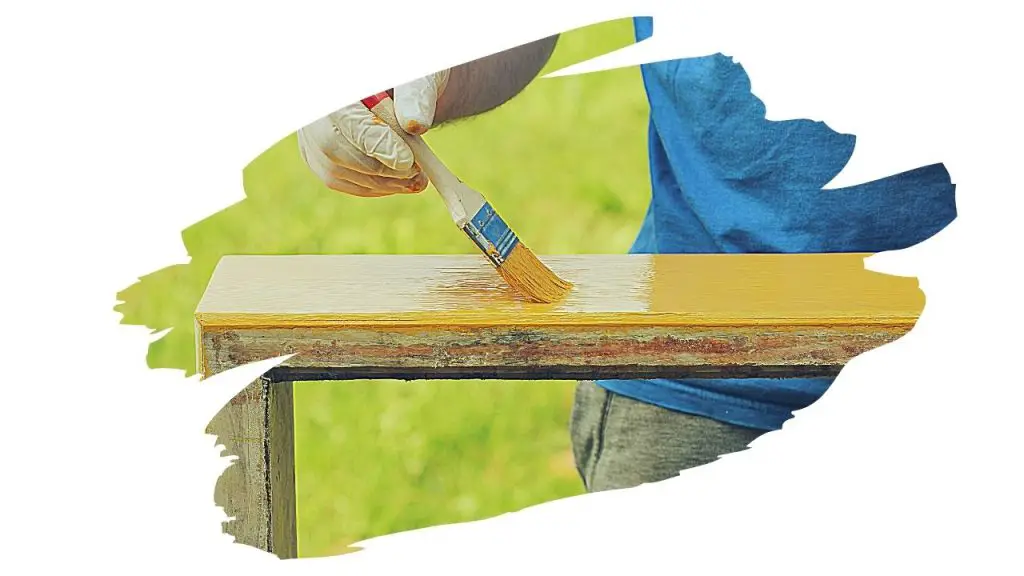If you want to inject color into fading wood furniture, then using wood stain can at first seem like an easy way to bring some life back into those finished work pieces.
But, can you stain over oiled wood?
When we apply a coat of typical stain to wood, we want the stain to seep deep into the wood in order to change the natural color of the lumber. When we use a typical oil finish on wood, such as Danish Oil, these oil finishes are designed to cure and harden into a protective barrier. That barrier seals in the wood so effectively, that it can prevent even moisture from getting into the grain (which can cause rot). So, if you were to apply stain onto oiled wood, it won’t be able to penetrate the surface of the wood.

This post may contain affiliate links to products that we receive a commission for (at no additional cost to you). Learn more here.
When Can You Apply Wood Stain After Oil?
Now, you might be looking at your finished furniture piece, scratching your head as to what to do.
Well, before you throw in the towel, there are a couple of exceptions when it comes to staining on top of an oil-based finish;
- Non-Curing Oil Finishes
This type of oil soaks into wood, but doesn’t solidify into a hard exterior. Instead, it stays kind of ‘damp’ and wet. So, more often than not, it needs to be reapplied every now and then. For example, Mineral Oil is a non-curing oil-based sealer, one that is often used on items such as Butcher Blocks.
In the case of these non-curing oil-finish types, you can apply stain over them. However, you might still find that the stain doesn’t evenly seep into the wood surface. And that can leave the wood looking splotchy, and a complete mess.
- Use A Gel Stain
There are a number of different types of wood stain on the market.
You can get oil-based stains, water-based stains, or varnish wood stains.
One commonality between all of those stain types is that they work primarily by soaking into wood.
However, gel stain gives texture and color to timber by sitting on top of the wood, (in a similar way to paint).
The advantage of applying this stain type onto oiled wood, is that it doesn’t need to sink into wood for it to be effective.
Now, having said all that, we are going to cover the top 5 most popular oil finishes, and examine whether you can apply a stain over them…
1 Can You Stain Over Danish Oil?
What Is It?
This wood finishing oil – typically made from a varnish and tung oil blend – is used to add a water-proof layer onto bare wood.
You would add this protective base-coat before painting or varnishing pieces such as furniture.
Can You Stain Over This Finish?
If you are using oil/water based stains, then applying stain directly over the Danish oil finish isn’t going to work.
The one caveat to this, is if you use a gel stain to ‘paint’ your stain color onto the wood piece instead.
Otherwise, in most instances, a typical stain solution just won’t be able to reach the wood surface. And this is all thanks to Danish oils ability to brilliantly fill in those pores, latch onto the grain, and harden into a durable resin.
You could try removing the Danish oil coat by lightly sanding down until you reach the bare wood surface again. Or you can use chemical stripper to remove the finish.
Once the finish is scraped/sanded off, you might find the stain will take to the wood. However, this is still likely going to end up with the stain looking all splotchy anyway.
If you’ve never considered using Danish Oil, then why not click here to discover more about this popular finish: All About Danish Oil (Advantages And Disadvantages).
2 Can You Stain Over Linseed Oil?
What Is It?
This finish is pretty much like Danish Oil (in fact, some Danish oils are made with a Linseed oil blend). However, Linseed oil tends to dry slower than Danish oil. It is also not as durable as Danish Oil either.
But, Linseed oil can still soak into wood and give it a satin-rich appearance.
Can You Stain Over This Finish?
Once again the answer is, No. Unless, of course, you are using a gel stain to get the job done.
Otherwise, you can’t stain over linseed oil-based finish with typical oil-based/water-based stains. The stain just won’t take.
Related Post: Can You Put Polyurethane Over Gel Stain? (Best Practice Revealed!)
3 Can You Stain Over Tung Oil?
What Is It?
Tung oil is a natural dry oil used by woodworkers around the world to finish fine furniture.
Once dry, tung oil becomes non-toxic (which is why it is so frequently used to coat wooden food utensils).
Can You Stain Over This Finish?
No, this oil isn’t one for staining (unless using gel stain).
Why? Well, because Tung oil is especially good at seeping deep into wood and fusing with those fibers. All while curing into a hard and water-repellent outer shell.
Which means it is going to be very difficult to remove, (if you decide to sand/scrape your way back down to the bare wood).
Related Post: Can Mixing Stain With Tung Oil Work? (How To Darken A Tung Oil Finish)
4 Can You Stain Over Mineral Oil?
What Is It?
This food-safe wood finish needs a bit of ongoing TLC just to keep it look so fresh and so clean.
However, the clear coat it leaves behind goes wonderfully with bold-color natural wood grain.
Can You Stain Over This Finish?
Yes you can, provided that you are using an oil-based staining product.
If you were to use a water-based stain, it would struggle to adhere to the Mineral Oil coat.
Still, an oil-based stain would be able to penetrate the wood. Especially since Mineral Oil finishes don’t cure and harden the way Tung Oil and Linseed Oil finishes do.
5 Can You Stain Over Teak Oil?
What Is It?
Commercial teak oil comes from a blend of a little of all the above.
It is made from a mix of tung oil, mineral oil (sometimes), linseed oil, and even a touch of paint thinner (otherwise known as Petroleum distillate). And it doesn’t stop there, as there are usually extra additives thrown into the mix.
It dries fast and gives wood a brilliant appearance.
Can You Stain Over This Finish?
No, this is not a finish that you can easily apply a typical water-based or oil-based stain onto.
Teak oil, (thanks to it being a hodge-podge of a little of everything), usually has additives that will stop the stain from staying on.
But, Is Oil-Based Wood Stain Any Good For Wood?
Well, most oil-based wood stains are really just a combo of two things; the pigments, (which give it its color), and the binders, (which hold everything together).
For oil-based stains, the binder ingredient can be as simple as varnish, linseed oil, or even polyurethane.
Actually, this is mainly the reason why some people mistakenly believe they can mix oil based stains with oil-based coatings.
Quick Side Note: You can’t, not really. Well, not if you want a nice and even coat of color. But you can learn more about this here: Can You Really Try Mixing Wood Stain And Danish Oil Together?
Now, these binding ingredients are all great wood sealants. So, your craft won’t get damaged by using an oil-based stain containing them.
In fact, comparatively, oil-based wood stains can sink much deeper into the wood than water-based stains.
Which is why oil-based wood stains are more durable than water-based ones.
Still, before you get too excited, there are three key points to consider…
First off, oil-based stains release VOCs (Volatile Organic Compounds). And the VOCs inside wood stains are those lung burning fumes you smell the moment you open up that can.
Second, oil-based stains take a lot longer to dry than the watered-down stuff. So, if you live in a humid climate, you might find yourself in for a long wait till that wood stain is ready to use.
And last, putting a penetrating wood sealant over wood stain is a no-go.
Whether they’re oil-based or water-based, it’s just not gonna work. And we dive more into the how’s and why’s of this in our post here: Don’t Put Hard Wax Oil Over Wood Stain (Do This Instead…)
Final Thoughts
If your oil treated furniture needs a bit of extra color, then simply slapping on some stain won’t turn out well.
When oil-based finishes harden, they prevent anything, (not even so much as a droplet of water), from soaking into the wood.
And as stains work by doing exactly that, (seeping into the wood so as to alter the natural color of lumber), applying stain over an oil finish isn’t going to work.
At best, the stain will come up blotchy. And at worst, it won’t even adhere to the oil finish in the first place.
The only exception would be to use a gel stain instead, as this stain type works by sitting on top of wood (rather than seeping into it).

![Will Tacky Wood Stain Eventually Dry? [What To Do When Stain Is Not Drying] will tacky stain eventually dry](https://www.thewoodworkplace.com/wp-content/uploads/2022/10/Banner-502-150x150.jpg)

